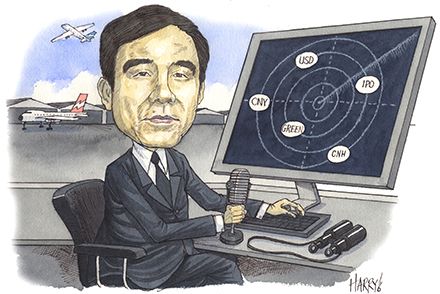In a year when Chinese investors were the driving force behind Asian investment banking, one bank captured the trend, mobilising mainland capital for local and global issuers. For its strong performance in both debt and equity capital markets, Bank of China is IFR Asia’s Asian Bank of the Year.
Bank of China led the way in matching mainland investors with overseas investments in 2016, with a growing presence in both the debt and equity capital markets. It followed its onshore issuer clients overseas, continuing its march up the underwriting league tables, and also connected global companies with Chinese capital in both the offshore and onshore markets.
BOC used its global network to full advantage in 2016. It handled a series of acquisition financings for Chinese companies looking to expand overseas, showing the power of its balance sheet in supporting the mainland’s global push.
It led Hong Kong IPOs for several mainland lenders, as well as companies in the consumer sector and for its own aircraft leasing unit, and it delivered US dollar bonds for Chinese clients and expanded its distribution and origination coverage beyond its home market.
The bank also connected global issuers with Chinese investors, leading more Panda bonds than anyone else, and it led by example as an issuer, launching landmark deals to set benchmarks and stimulate the Green bond market.
Chinese capital flows were the defining feature of 2016, with the renminbi’s continued slide driving demand for overseas assets – especially in US dollars. That played to BOC’s strengths, but the bank also worked hard to develop the renminbi markets both onshore and offshore.
Crucially, the group showed it can handle more complex financings and underlined its capacity for innovation in 2016. While many Chinese arrangers won a bigger share of Asia’s capital markets in 2016, it is the maturity of BOC’s platform and the breadth of its product suite that leaves it best placed to build on that growth.
Bond business
BOC was again the leading Chinese arranger of G3 currency bonds in Asia in 2016, widening the gap over its closest mainland rival.
It grew its share of G3 underwriting in a competitive market, rising to sixth on the Thomson Reuters league table for Asia, excluding Australia and Japan, for the review period, up from ninth for the previous 12 months.
Chinese clients were key to its success. BOC ranked second for China G3 bonds in the 2016 review year, up from eighth a year earlier, leading deals for financials and heavyweight state-owned enterprises such as Sinopec. It also helped Chinese property developers, such as Country Garden, return to the US dollar bond market, and a rush of local government financing vehicles access the international markets for the first time.
It also expanded its distribution capabilities, taking Chinese clients to Singapore and Taiwan, and deepened its coverage of European investors, including Eastern European central banks and Nordic insurers. It also expanded its syndicate desk in London during 2016.
In Asia, BOC delivered anchor investors for offshore bond issues, and focused on joint global coordinator roles to maximise underwriting commissions. Chinese banks were major buyers of offshore Chinese credit in 2016, and BOC balanced the needs of its treasury and investment arms to help its clients access capital.
It connected yield-hungry mainland insurance companies with US dollar opportunities, helping China Cinda Asset Management and Huishang Bank raise Additional Tier 1 capital at attractive terms.
The bank established a leading position in the Panda bond market, with a key role in Poland’s Panda bond, the first sovereign issue from Central and Eastern Europe. It was also lead underwriter for Veolia Environnement, the first corporate Panda issuer from France, and joint lead underwriter for National Bank of Canada, the first financial issuer from North America.
It also kept the Dim Sum market ticking over, despite the pressure of renminbi depreciation, with landmark deals including Hungary’s Dim Sum bond and the Chinese Ministry of Finance’s debut offering in London.
BOC operates in 46 countries outside of China – the most among the country’s big five state lenders – but runs a more coordinated capital markets platform than its peers. Overseas branches have a degree of funding and investment autonomy, but head office is intimately engaged in offshore debt underwriting, using the Hong Kong branch as the offshore financial markets hub for the group.
That approach results in a more consistent approach to both issuance and credit approval, helping BOC position itself as the leading benchmark issuer from China’s financial sector.
Its landmark offshore issue in 2016 was a US$3.03bn Green bond, issued in US dollars, offshore renminbi and euros and split between the New York and Luxembourg branches.
The July 4 issue was the first benchmark-sized bond from Asia since the June 23 British referendum, effectively reopening the market. It also drew a strong following from European green funds, with 76% of the €500m (US$552m) euro tranche going to EMEA investors, far more than was typical on other Chinese issues during the year.
It followed that up with a secured Green bond towards the end of the review period, using careful structuring to give offshore investors exposure to a pool of onshore green assets.
Though government policy clearly plays a part, the group’s issuance in 2016 highlighted its commitment to innovation. Western bankers described the bank’s treasury function as smart and sophisticated, with very clear ideas of what it wants from a trade.
Brand equity
BOC worked on 15 overseas equity raisings for Chinese clients during the review period, a 50% increase on the previous year, jumping to 11th from 18th on the China ECM league table, excluding A-shares.
BOC International, as one of the two sponsors, arranged the HK$8.74bn (US$1.13bn) Hong Kong IPO of BOC Aviation in June. The aircraft-leasing subsidiary of Bank of China adopted a rare fixed-priced approach to sell shares to investors, in a bid to lure foreign cornerstone investors such as Boeing and Oman Investment Fund.
When most Hong Kong IPOs traded below water after listing, two of the floats BOC International led in the year – the HK$1.61bn IPO of power generator maker VPower Group and the HK$754m listing of Hong Kong generic drug company Jacobson Pharma – bucked the trend. Shares of the former rose as much as 11% while the latter as much as 17% since listing.
The Chinese bank also showed its credentials in listing Chinese city lenders. It arranged the HK$7.68bn Hong Kong listing of Bank of Tianjin and the Rmb7.24bn (US$1.08bn) Shanghai IPO of Bank of Jiangsu. While Chinese regulations prevent banks from underwriting domestic share sales, BOC International (China) operates onshore under a separate licence.
In the loan markets, Bank of China’s balance sheet played a key role in China Inc’s overseas expansion.
State-controlled conglomerate Beijing Enterprises Holdings relied on BOC for a €2.5bn (US$2.75bn) one-year loan in February to back its acquisition of Germany’s Energy from Waste from Swedish private equity fund EQT. A month later BOC’s Macau branch closed a US$2.05bn term loan with another Chinese bank, supporting the management buyout of medical devices manufacturer Mindray Medical International.
BOC was sole bookrunner on a US$900m seven-year facility for China Molybdenum’s US$1.5bn acquisition of Anglo American’s niobium and phosphates business in Brazil. BoC structured the three-part loan, which included a US$260m tranche with Export-Import Bank of China to keep the borrowing costs low. Within weeks of signing the loan in mid-September, BOC won the sole mandate on a similarly structured US$1.59bn loan for China Molybdenum’s US$2.65bn purchase of a majority stake in the Tenke copper mine in the Democratic Republic of Congo.
It was also on the top line of lenders on the US$3.5bn non-recourse loan backing internet giant Tencent Holdings’ acquisition of a majority stake in Finnish mobile game developer Supercell, and one of four leads on a S$1.75bn (US$1.26bn) five-year loan in June backing Universal Terminal Services’ acquisition of oil storage assets.
BOC’s global network holds it to higher standards than most, and it has had no trouble engaging international investors for its own deals or for its clients.
Building a sustainable overseas platform will be key if China’s banks are to reduce their dependence on net interest income as the mainland economy cools and interest rates come down.
BOC is showing signs that it can do just that. It delivered a 2.4% increase in third-quarter net profit even as margins shrank and bad loans rose. It earned Rmb41.8bn (US$6.2bn) in the July to September period, beating estimates, but its net interest margin fell to 185bp from 190bp at the end of June. The group’s non-performing loan ratio rose only slightly to 1.48% from 1.47% three months earlier.
To see the digital version of this report, please click here



